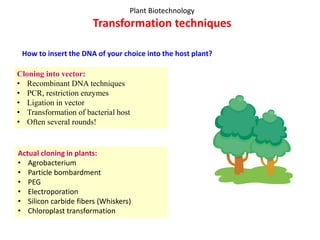
Nitrogen fixation and agarobacterium_251
- 1. Plant Biotechnology Transformation techniques Actual cloning in plants: • Agrobacterium • Particle bombardment • PEG • Electroporation • Silicon carbide fibers (Whiskers) • Chloroplast transformation How to insert the DNA of your choice into the host plant? Cloning into vector: • Recombinant DNA techniques • PCR, restriction enzymes • Ligation in vector • Transformation of bacterial host • Often several rounds!
- 2. Plant Transformation: the Agrobacterium method Plant transformation: Agrobacterium-mediated gene transfer T-DNA Binary vectors Selectable markers What to achieve with/expect after transformation?
- 3. Agrobacterium-mediated plant transformation Agrobacterium • Gram negative soil bacteria • Flagellum; motile • Infect plant at wounds in root • Chemotaxis • Transfer of part of DNA from Agrobacterium to plant • Inter-Kingdom horizontal gene transfer • Result: crown gall (in case of A. tumefaciens) • Bacterium uses plant to produce shelter and food • Parasitic Most Agrobacterium species are free living and saprophytic. Four exceptions: • A. tumefaciens crown gall • A. rhizogenes hairy roots • A. rubi cane gall • A. vitis tumours on grape vine?
- 4. Crown galls on peach seedlings Gene transfer causes tumours 1. How does gene transfer work? (“oncogenes” introduced) 2. Can we manipulate Agrobacterium and introduce genes of interest?
- 5. Mechanism of Agrobacterium transformation Agrobacterium in rhizosphere •Wound in plant tissue •Chemicals released •Agrobacterium moves towards wound (“chemotaxis”) •Infects plant cells •Part of DNA is transferred to host plant cell: •T-DNA •Genes on T-DNA induce tumour •Beneficious for Agrobacterium (not for plant!)
- 6. Ti-plasmid of Agrobacterium Ti-plasmid •Large circular plasmid (200 kb) •Vir-region •Opine production •Origin of replication •Transfer region •T-DNA region •LB/RB
- 7. The Vir genes are instrumental in the transformation process • VirA senses phenolics / sugars (wound) • Vir A is a kinase: • It first autophosphorylates • phosphorylates/activates VirG • Activates VirG • VirG induces expression of all Vir genes • Vir G is a transcription factor • VirD1/VirD2 recognise and excise T-DNA • VirD2 nicks DNA (single strand) at LB and RB • VirB forms channel through plant cell membrane • VirD2/virE2 transport T-DNA to nucleus (NLS) through nuclear pore Transcriptional regulation Post-translational regulation
- 8. Excision of T-DNA and transport by virD/virE2 • Single-strand nicks are made at LB and RB • A single stranded T-DNA is excised • The remaining ss part of the T-DNA on the Ti-plasmid is repaired to double stranded DNA
- 9. Transfer of T-DNA / vir complex to plant cell
- 10. 3’ LB 5’ RB T-DNA excision and transport • RB nicked first • If excision incomplete: 3’ end missing • Early T-DNA design: SM at 3’ end However… • 5’ end protected by VirD1 • 3’ end unprotected • 100s of nucleotides may be deleted by exonucleases • Modern design: SM at 3’ end of T-DNA Dynamics of T-DNA excision – consequences for construct design
- 11. Transfer of T-DNA into the nucleus of plant cell Note that integration is random! Directed integration possible in other organisms How to obtain directed intergration in plants…?
- 12. Once integrated in the plant genome… T-DNA: •Auxin •Cytokinin •Opine/agropine •LB/RB: 24 bp repeats: Plant hormones – growth – “oncogenes” Carbon source – energy source Necessary for integration in plant genome
- 13. Agrobacterium lives in crown gall
- 14. How to use this system? Not interested in: -Tumour -Opine synthesis Replace tumour + opine genes with genes of interest; include selectable marker Leave LB + RB in place! Vir genes still necessary
- 15. Development of transformation vector Binary vector •Shuttle vector: E. coli – Agrobacterium – plant •Smaller than Ti-plasmid (10 kb vs 200 kb) •No tumour induction •Stable integration of T_DNA in plant genome Widely used approach: Agrobacterium -”disabled Ti-vector” (+ vir genes; - tumour genes) -binary vector (LB/RB; gene of interest; selectable marker
- 16. Agrobacterium mediated transformation A combination of vectors is used: • Disarmed Ti-plasmid: vir region present, but T-DNA deleted • Binary vector with T-DNA
- 17. What’s on a Binary vector?
- 18. A bit more detailed – what do we need? Promoter (homologous/heterologous) Gene (cDNA or genomic; intron 1 included?) Terminator of transcription (for correct poly-A addition)
- 19. pBin19: the Mother of all binary vectors What’s on T-DNA and why…? •LB / RB •Pnos •npt2 •nosA •lacZ •mcs What to insert? •Promoter •Gene of interest
- 20. How to transform plants with Agrobacterium? Root transformation Protoplast transformation “Floral dipping”; whole plant submerged in Agrobacterium- solution Selection (callus growth or seedling/plant growth on selective medium)
- 21. Selection: why and how? Transformation efficiency usually low •Most plants / cells have not taken up T-DNA •Selection for positive transformants needed Plant selectable markers: •Antibiotics npt2 (kanamycin) •Herbicide resistance bar, EPSP •Other markers Problems: do we want to introduce these genes in our crops? Resistance? Escape in wild species? “superweeds?”
- 22. Transgene expression Possibilities for transgenes in plants: •Over-express a gene •Introduce extra copies •Express from strong promoter •Ectopic expression •Express a novel gene (Cry-genes in Bt, herbicide) •Silence a gene •Introduce anti-sense gene (Flavr Savr tomato) •RNA-i technique (RNA-interference) [GA20-oxidase] •Knock out endogenous gene (Arabidopsis) [Ceres-example] Your transgene may knock out an important gene! => Always screen several transformants
- 23. Agrobacterium mediated transformation • Efficient in dicots • However, increasingly used in monocots as well • Adapted for use in transforming fungal, yeast and human cells as well! • Hypervirulent strains: extra Vir genes, higher Vir gene activity • Mainly A. tumefaciens; other species useful? • Transformation of protoplasts; regeneration of plants • Leaf disc transformation • Floral dip (aim for transformation of gametophytes) • In all cases: hemizygotes • Often back-crossed in desired crop varieties • End with selfing to obtain homozygous plants
- 24. Summary Agrobacterium-mediated transformation •Ti-plasmid •Vir-genes •T-DNA •LB/RB •Oncogenes •Opine synthesis Binary vectors: •T-DNA (LB/RB) •Selectable marker •Mcs Combine with disarmed Ti-plasmid •Vir-genes => Vector for transformation & expression of foreign DNA into plant cell